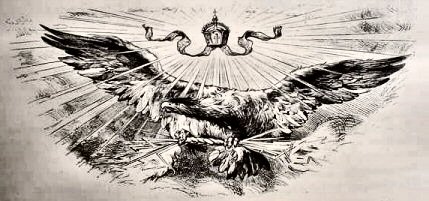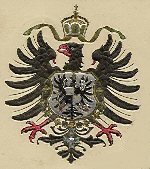|
|
|
|


Weapons
Page 3
|
|
Please be sure to visit our Kaiser Wilhelm II collection.
Also, take a look at our Frederick the Great gallery.
|
|
|||||
|
Prussian Mod 1889 Officer's Saber (Degen) (Item KWEP 3-1) |
|||||
| DESCRIPTION: Here is a larger version of the favorite sidearm of the Prussian Officer corps. The condition is only fair with the scabbard throat connector missing. The ray-skin grip is a bit tarnished (will clean up!). The finial cap is a bit loose. The brass fittings have the green tarnish of age. (We do not clean them!) This will clean up very easily and it can be bright as a monkey's behind. This is almost the grosse Degen (the large model) and it is in the dress-parade scabbard-nickeled instead of black paint. The blade is the problem, although it is all there. It is pitted and the plating is worn through here and there. This scabbard is the two-ring style. Some call this the 1870 model. It does not have the Wilhelm II cipher leading us to believe that it is indeed the 1870 pre-Wilhelm II model. It is entirely possible that the scabbard fitting was lost in the field because it seems the previous owner (the officer, himself) has tied the portepe in a very unusual manner where it drops down and actually cushions the area where cross guard meets scabbard. This obviously was done in a most clever manner to make up for the missing part. The scabbard also has some unusual tarnishing or stain at its middle-to-bottom back portion. Will it clean up? or perhaps it shouldn't. It is, after all, a good, honest Franco-Prussian War relic that would be considered quite rare, today. Length in scabbard 40 inches. Used, but still proud!
PRICE: SOLD |
|
|
|||||
|
Prussian Mod 1889 Infantry Officer's Sword (Item KWEP 3-2) |
|||||
| DESCRIPTION: Here is a very nice example of the favorite sidearm of Prussian officers in World War One. This is a nice, clean example with an unmarked (issue) blade with double blood groove that is in bright steel. The blade is in excellent plus condition. The ray-skin-wrapped grip shows natural wear, but is intact with slight scuffing. The wire wrap is in place and tight. The fittings of brass show some of the original gilding. The empire eagle shows quite a bit of it. The length in the scabbard is 37 � inches. The scabbard has the original paint that is in good condition. Overall, a very nice example of the "89" that has become almost the symbol of Prussian militarism.
PRICE: $650.00 |
|
|
||||
|
Prussian Infantry Officer's Degen (saber) (Item KWEP 3-3) |
||||
| DESCRIPTION: This is a Model 1889 saber with folding cross guard. This particular model is a bit different than the usual in that it has a grip of custom ebony wood instead of the more usual ray-skin type. The blade is unmarked as far as maker. It has the double blood groove and is in fair, used condition. Most of the gilt still shows on the grip fittings. There is slight bending to the scabbard at its middle portion. We in the field believe this invariably happens when the sword worn hanging low is slammed in doors from time to time when the owner forgets what he is wearing and what often trails behind! The grip is intact with the wire wrapping in place. There is a finger strap inside (this was optional). All in all it is a very nice Prussian sidearm for an officer and a nice valued addition to any Imperial collection. It measures 38 inches long in scabbard.
PRICE: $750.00 |
|
||||||||||||
|
Magnificent Grosse Degen (Large Imperial Sword) (Item KWEPS 3-4; WWI 6-4) |
||||||||||||
| DESCRIPTION: This is the very-large-grip presentation sword and it is a great one! It's a model 1889 with the stationary grip guard, but at that point it differs from the ordinary '89 in that it is definitely the deluxe presentation grade with floral-pattern decoration in brass and raised mode all over the guard and pommel. Even the grip-end roundel is magnificently decorated with elaborate floral chasing. The blade, � gilted, is also with fine, raised-floral design on both sides. The sword was presented form one Imperial Army officer to another and this presentation read in bold, raised letters: "Jordan s./l. Stifft," "s./l." standing for Seinen Leben (to my dear). The rest of the blade is brilliant and bright and triple grooved. On top of the edge (opposite the cutting edge) the sword's provider is shown, also in fine, raised letters: "M. Neumann Hoflieferant Berlin." "Hoflieferant" means that this supplier was a provider to the Royal Prussian Palace and was granted the honor of using this title on his grand offerings. The grip is of ray skin and is in fine condition as is the entire sword. Tom Johnson, the dealer from whom this fine piece was purchased, originally had the scabbard repainted and a superlative job was accomplished, indeed. The overall length in the scabbard is 41 inches. This was a very costly gift even in its day (probably the 1890's) and now it is being offered for a very fair and equitable price.
PRICE: SOLD |
| |||||||||
|
Danzig Wolf�s Head Hunting Sword (Item KWEP 3-5; HUNT 5-8) |
|||||||||
| DESCRIPTION: This is a very unusual hunting weapon of the peculiar type used in the Danzig area. It probably dates from the early 18th century, but also could be mid-to-late 17th century. The head or pommel that is usually a deer, dog, or eagle is a wolf on this particular piece. The grip is black-ribbed leather that has started to get a rather neat green patina from age. The cross guard has claws that resemble the claws of a bird of prey and the back guard has featherlike overlaying design (curious). The mixture of bird and wolf (myth?). The face of this predator is strange indeed, having almost a sinister countenance. The scabbard is leather with a metal tip. The top portion has a fitting for a frog attachment, but does not appear to ever had a throat. It is 28 inches long in scabbard. The blade measure 21 inches long. The chain guard is a new replacement put on by the former owner. Other that that the weapon is in very fine condition for its obvious antiquity. This is a fine historically important relic.
PRICE: SOLD |
| ||||||||||||||||||||||||
|
Super-Rare Imperial Naval Dirk, 1890 Pattern-Damascus (Item KWEP 3-7; KRIEG 4-18) |
||||||||||||||||||||||||
| DESCRIPTION: Other than the famous Prince Adelbert naval dagger that we owned at one time, this dirk is probably the most important one ever offered because it was owned by one of the most important figures of the German Navy, Gerhard Stubenrauch, who was born 07/02/1880 and entered the German Navy on 01/04/1897 at the age of 18. In 1914, he saw service on the line ship Pommern as a navigation officer. By February of 1916, he was the commanding officer of the line ship Wettin and he was assigned to the Marine Inspection Division. It seems that he had flying experience and quickly traveled up the ladder in the new sea-flyer section as a staff officer in this fabulous addition to the Imperial fleet. By January of 1917, he was commandant of the marine command Mackensen and by June of 1917, it seems he was the commander of all the air arm of the Navy. After WWI in 1918, he was first officer on the battleship Moltke. In 1919, he retired, but in August of 1919, he reenlisted and was a Fregattekapit�n. He is listed in the Kaiserlich Deutschen Marine of the year 1914. He was a recipient of the Red Eagle Order of Prussia (Grand Cross) and before he had the fourth class he had earned the Iron Cross First Class and the Rettungsmedalle with clasp of honor. He served his Fatherland faithfully and we are honored to now offer his personal dirk to a museum or to a serious collector who is interested in the finest historically important Imperial naval dirk ever offered. The piece is about 19 inches long in its scabbard. The wonderful Damascus blade measures 13 � inches long. The grip appears to be ivory, although this was the period when the celluloid grips were introduced so the color that matches ivory in hue probably is the celluloid variety. The carrying bands on the scabbard are in the simulated reef knot or figure-8 variety. It was in 1901 that Kaiser Wilhelm II decreed the restitution of the naval dirk for officers. This example is very similar to the one pictured in Thomas Wittman�s fine book, Exploring the Dress Daggers of the German Navy. Look on page 98 and you can see a dagger from Tom�s great collection. This one is just about a dead-ringer for the one we offer here right down to the pattern of the Damascus and the pebbling in the center block background. The one pictured at the top of page 99 is similar, except ours has the closed crown, not the open type shown. There is a different maker mark shown on the tang, also, which might be �BWH�? Only a few Damascus smiths ever produced these magnificent naval blades. The blade of this dagger is particularly gorgeous in the very finest maiden-hair pattern, but the wonderful feature is found in the fact that Commander Stubenrauch�s name is seen raised in a panel on the blade near the cross guard. His name also appears engraved near the throat of the scabbard. The condition of the dirk is quite fine overall with some darkening of the brass on the scabbard (pure age). There is a small notch where the pommel crown meets the grip. Why??? The original portepee is there, but a little distressed from wear. The commander wore it on a daily basis. My friend, Tom Wittman, considers this to be a prodigiously important dagger both in very important significance, but also for its rare blade in great personalized Damascus presentation. All in all, they really don�t come much better unless you are talking the Prince Adelbert dagger, and we dearly miss that one.
PRICE: SOLD |
| ||||||||||||||||||||||||||||||
Please refer to item designator in parentheses in all correspondence. Please E-mail for any additional information you may need.If you prefer, contact 'Germania' at PO Box 68, Lakemont, GA 30552 or call at 706.782.1668. Please! do not call during the wee hours of the morning. The best time for calling us is between 9 and 11 am and between 9 and 11 pm eastern time. |



























































































